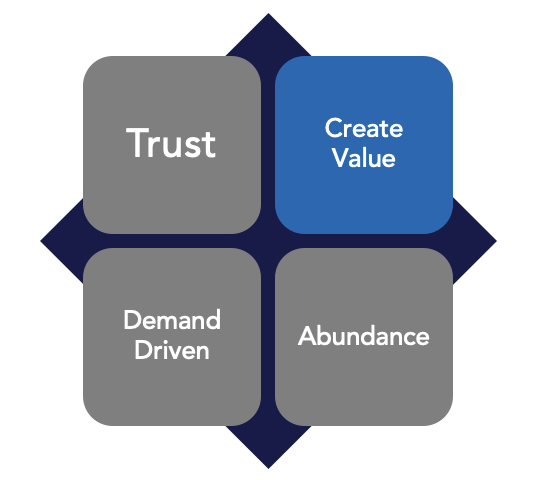Create Value
Work tasks, think big picture.

Tasks done in the absence of understanding the "why" are not likely to create the intended outcome or value.
It is not sufficient to just tell people what they should do they must also understand why.
It is critical that people understand the "why" of the organization and how their contribution fits into the big picture. And, people must believe in and buy into the big picture. People's success in creating value for the organization is a combination of their decision-making and their skill in completing tasks in the context of the organization's vision.
The golden circle by Simon Sinek reinforces the start with why idea.
Equally important to the understanding of and buy-in to the vision is the measurement framework we use to provide knowledge workers with visibility to the impact of their contribution. The measures must be effective in promoting learning and growth as well as assessing the creation of value.
We can see examples of wasted energy and dysfunction across many industries where the measure of contribution is based on activities rather than outcomes. This is too often true in support organizations where the measure of contribution is counting the number of cases closed or the number of knowledge articles written. These misguided goals result in undesirable results, such as annoyed customers due to premature or inaccurate case closures, or a knowledge base that is full of duplicate or useless articles. If people do these activities with the goal of enabling customer success, they are more likely to do the tasks in ways that will achieve that goal. Even better if the recognition for one's contribution is based on their contribution to the outcomes, not the activities.
In the hotel industry, there was a time when salespeople had a goal (and a bonus) based on the number of potential clients they hosted on site visits. While the intention was good, this ultimately drove undesirable behavior. Site visits are expensive for a hotel as they often include free rooms and meals for prospects. Instead of spending time and resources connecting with qualified prospects, salespeople were incentivized to find warm bodies to bring to the hotel, even when the probability of those visits turning into revenue for the hotel was very low. They could make the number and earn their bonus, but this was not creating value!
Leadership Challenge
Create a Vision
If we search for a definition of the word "vision," we will find no shortage of results. In the absence of a standard on what constitutes a vision, we have defined it as having the following four elements:
- Compelling purpose: a brief value proposition (3-5 words)
- Mission: how we intend to deliver on the value statement
- Organizational Values: how we interact with each other, behavior norms
- Brand Promise: what we want our customers to say about us to others when we are not present
Communicate the Vision
Communication is a key part of any successful change initiative. In today's environment, it takes patience and persistence on the part of leadership to ensure employee understanding of and buy-in to the vision. Consistency and frequency are key in getting the message across.
Apathy is death to any transformation initiative. The messaging needs to be something employees can relate to and help them see how they fit in the big picture. The goal is to create a sense of belonging. The antidote for apathy is to help employees see the impact of their contribution and feel a sense of pride about being part of the organization. The messaging and the measures need to enable employees to see the impact of their contribution and reinforce their understanding of how they fit in the big picture.
Patrick Lencioni talks about the importance of shared goals in enabling high-performing teams in his book The Five Dysfunctions of a Team.
Alignment with the Vision
As we mentioned in the section on Trust, leadership's behavior and decision-making must align with the vision. Any behavior or decisions that are contrary to the stated purpose, mission, values, or brand promise will erode trust and diminish employees' interest in creating value.
Also mentioned earlier (but we can not emphasize this enough), the measurement framework must align with and support the vision. Unfortunately, we often see activity-based or task-based goals that promote employee activity that doesn't contribute to the stated outcomes. This is not just a missed opportunity to achieve the stated goals, it is actually disruptive to the organization and will quickly undermine a change initiative.
Any disconnect between leadership's behavior or decision-making and their stated vision, or a disconnect between the measurement framework and the stated vision, will lead to failure of organizational transformation.
Summary
Our goal is to create an environment where people understand and are bought into the organization's vision. If they are engaged and understand how their activities fit in the bigger picture, they are better equipped to make good decisions about their work that will create value.
References
- Develop a Vision in the KCS v6 Practices Guide
- The Five Dysfunctions of a Team by Patrick Lencioni

